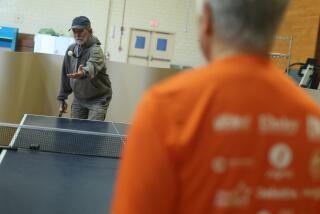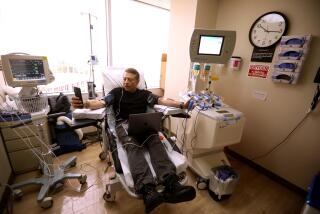Volunteers Spend a Lifetime on Age Studies
- Share via
BALTIMORE — Along with their weekly floor hockey battles, Sunday brisket dinners and annual beach week, the Mallonee clan of Baltimore shares another tradition, one that has lasted three generations. Family members visit an obscure research facility and undergo some of the most extensive medical testing in the world.
They contribute blood, urine and skin cells. They submit to bone scans, kidney-function tests and psychological questionnaires. Some family members use vacation days and pay their travel costs to be a part of the Baltimore Longitudinal Study of Aging.
The world-famous project is considered the granddaddy of research into aging. For more than 40 years, researchers have been tracking the health of hundreds of adults.
The study’s scientists have unearthed some of the most important truths about aging, overturning long-held assumptions such as the notion that people’s bodies are doomed to deteriorate. Instead, researchers found that by taking care of themselves, adults can control many of their graying years.
Similar projects died out long ago, but the National Institute of Aging study is going strong. Many say that’s because volunteers such as the Mallonees keep returning, year after year, decade after decade.
Ranging in age from their 20s to their 90s, the participants savor the old-fashioned breakfasts, the nurses who know them by name, the knowledge that every part of their bodies is being checked. For many, it is a point of honor, even a family tradition, to contribute to science.
“When I got married, I realized, ‘Hey, the rest of my family is doing this. It’s time to get involved,”’ said Katie Mallonee Burke, 32, of Essex, Md.
Her grandfather, Charles Gardner Mallonee, a 1928 Olympic lacrosse player and former athletic director at Johns Hopkins University, was one of the first volunteers. He encouraged his five children to join. Now, 16 family members are in the study.
Others couldn’t get in because the study is so popular. At a time when some research involving human subjects is under criticism, this project has a waiting list.
The participants say they feel like partners with the scientists, who eat with them during their stays and update them on recent findings. Staffers send them birthday cards. One volunteer met his wife while undergoing testing, and some volunteers became such good friends with staffers that they visit each other on weekends.
Many volunteers see the two-to three-day visits--which are scheduled annually or every few years, depending on age--as a reprieve from their everyday lives. In the evenings, after their tests, some join up to go out on the town. Family members, who like to coordinate their visits with relatives, stay up late talking and engaging in friendly rivalries over the tests.
“I think of it as sort of an adventure,” said Barbara Mallonee, 61, of Mount Washington, Md. “You just become a community while you’re there.”
The study’s collaborative tone was set in 1958, when a pioneer in gerontology, Dr. Nathan W. Shock, was approached by a retired public health physician, Dr. William W. Peter, who wanted to donate his body to science when he died.
“We need live people,” responded Shock, who thought researchers should study healthy adults living in the community.
At the time, research on aging was a backwater. Studies had been done only on sick people in hospitals and institutions.
Peter offered to become the first volunteer and then began a word-of-mouth campaign, recruiting about 80 neighbors and friends from his summer home. The word spread in the style of a chain letter, and over the years, organizers have rarely had to recruit. Most volunteers have been educated, high-income people, including Hopkins physicians, several local college presidents and Henry Wallace, Franklin D. Roosevelt’s vice president during World War II.
Over the past four decades, more than 800 findings have been published.
“It has been a revolutionary, groundbreaking study,” said Dr. William Applegate, an expert on aging and chairman of medicine at Wake Forest University in Winston-Salem, N.C.
Key observations about the development and evolution of diabetes have come from the project. Researchers detailed the effects of age on kidney function--important because that organ processes medicine.
Scientists also figured out how best to use prostate cancer tests and put to rest the notion that old people become rigid and depressed. Instead, they proved that a person’s personality is stable. One who is cheerful at 30 will still be at 80.
One of the most important themes to emerge from the Baltimore study is a hopeful one. Even though researchers have found that there is an age-related decline in most of the body’s organ systems, it’s much smaller than was originally thought. Many of the problems attributed to aging resulted from disease.
The one weakness of the project has been the similarity of participants. To make it more representative, organizers have been recruiting more minorities and women during the last few years.
All told, 3,155 people have been enrolled. Scientists say they can’t see an end for the project. Neither can the volunteers.
*
Diana K. Sugg is a health writer at the Baltimore Sun, a Tribune company.






